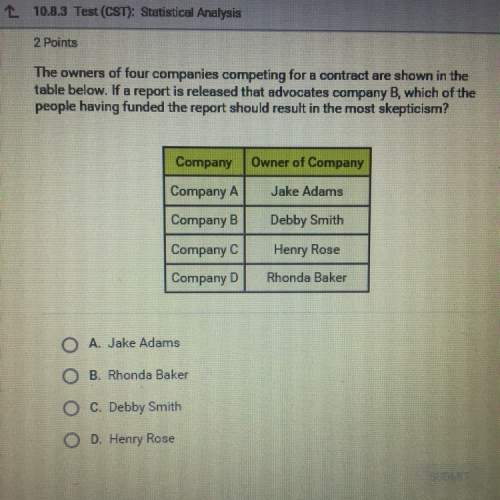
Mathematics, 15.07.2020 18:01 lolz55678
In the table below are the results of rolling a number cube 400 times. Number 1 2 3 4 5 6 Frequency 35 211 32 41 38 43 A. Based on the observed frequencies, calculate the relative frequency for each number. B. Based on your results in A, do the outcomes for rolling the number cube appear to be equally likely? Explain your answer using complete sentences. C. If the outcomes do appear to be equally likely, why are the observed frequencies different for each number? If the outcomes do not appear to be equally likely, identify a possible reason for this result.

Answers: 1
Another question on Mathematics

Mathematics, 21.06.2019 14:00
Find the area of a trapezoid with bases 14 cm and 18 cm and height 10 cm. 160 cm2 140 cm2 180 cm2 126 cm2
Answers: 3

Mathematics, 21.06.2019 19:30
Si la base de un triángulo isósceles mide 70 m y el ángulo opuesto a ésta mide 58°; entonces ¿cuánto mide la altura de dicho triángulo? a) 21.87 m. b) 40.01 m. c) 43.74 m. d) 63.14 m.
Answers: 1

Mathematics, 21.06.2019 20:00
Solve each equation using the quadratic formula. find the exact solutions. 6n^2 + 4n - 11
Answers: 2

Mathematics, 21.06.2019 20:00
It is given that the quadratic equation hx²-3x+k=0, where h and k are constants, has roots [tex] \beta \: and \: 2 \beta [/tex]express h in terms of k
Answers: 2
You know the right answer?
In the table below are the results of rolling a number cube 400 times. Number 1 2 3 4 5 6 Frequency...
Questions



Mathematics, 21.09.2020 14:01

Health, 21.09.2020 14:01



Mathematics, 21.09.2020 14:01

Mathematics, 21.09.2020 14:01

History, 21.09.2020 14:01


Spanish, 21.09.2020 14:01

Mathematics, 21.09.2020 14:01


Mathematics, 21.09.2020 14:01


Law, 21.09.2020 14:01


Law, 21.09.2020 14:01

Mathematics, 21.09.2020 14:01

Mathematics, 21.09.2020 14:01




